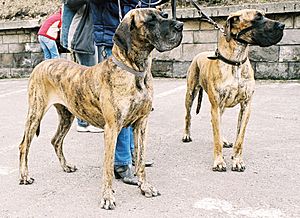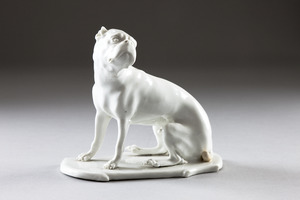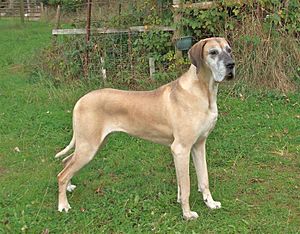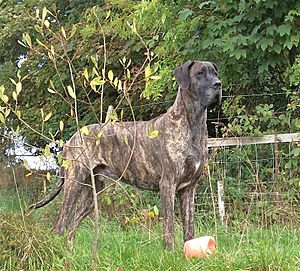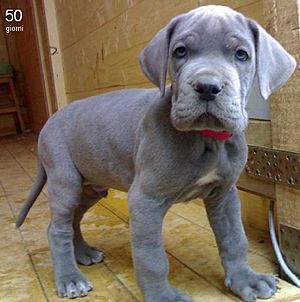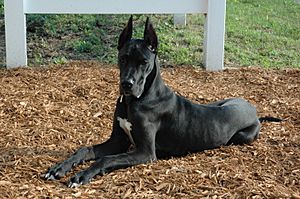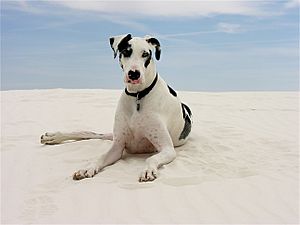Great Dane facts for kids

The Great Dane is a very large breed of dog. These dogs are known for their impressive size. They can stand about 2 feet (61 cm) or even taller at the shoulder. Great Danes come in several beautiful coat colors. These include fawn (a yellowish-brown), black, Harlequin (black and white spots), blue, brindle (striped), or mantle (black and white with a black "blanket" over the body). Female Great Danes are usually a bit smaller. They weigh about 110–132 pounds (50–60 kg) on average. Males are typically larger, often weighing 150 pounds (68 kg) or more.
Contents
Discovering the Great Dane's History
Large hunting dogs that look like Great Danes have a long history. You can see them in ancient Greece. Paintings on walls from Tiryns, dating back to 14th–13th centuries BC, show these dogs. These big hunting dogs continued to appear in Greek art for many centuries.
In the 1700s, people in Austria and Germany used special dogs from Greece. They bred them to make their local hunting dogs even bigger. These dogs were called "boarhounds." In Ireland, a similar process happened to create larger wolfhounds.
Even older images of large dogs exist in Scandinavia. They appear on runestones and on coins from Denmark around 500 AD. Old Norse poems, known as the Poetic Edda, also mention big dogs. The University of Copenhagen Zoological Museum has skeletons of at least seven very large hunting dogs. These skeletons date from 500 BC to 1000 AD.
Great Danes as Hunting Dogs
Around the mid-1500s, noble families in Europe imported strong, long-legged dogs from England. These dogs were a mix of English Mastiffs and Irish Wolfhounds.
These powerful dogs were used for hunting large animals. They helped hunt bears, boars, and deer for princes and kings. The favorite dogs even slept in their lords' bedrooms! These special "chamber dogs" wore gilded collars. They helped protect the sleeping princes from danger.
When hunting boars or bears, the "Englische Dogge" (English dog) was a catch dog. It would grab and hold the animal until the hunter could kill it. Over time, hunting methods changed, especially with the use of guns. Because of this, many types of hunting dogs became rare. The "Englische Dogge" was then kept more as a luxury pet than a working dog.
How the Great Dane Got Its Name
In the 1800s, English-speaking countries called this dog a "German boarhound." Some German breeders wanted to change the name. They tried to call it "German Dogge" or "German Mastiff." They wanted people to see it as a fancy dog, not just a working dog.
However, tensions grew between Germany and other countries. So, the dog's name changed again. It became known as the "Great Dane." This name came from the French term grand danois, which means "big Danish." This name was used by a famous French naturalist, Buffon, in his book from 1755.
Great Dane Characteristics
The Great Dane is a very large domestic dog from Germany. It is famous for its huge size.
The American Kennel Club describes the Great Dane as a dog that shows dignity, strength, and elegance. It has a powerful, well-built body with smooth muscles. It is one of the giant working breeds. However, it is special because its body is so well-balanced. This means it never looks clumsy. It moves with long, powerful strides. The Great Dane has short hair and a strong, fast-running shape.
Great Danes should have a "square" shape. This means their body length should be about the same as their height. Male dogs should be at least 30 in (76 cm) tall at the shoulders. Females should be at least 28 in (71 cm) tall. Dogs shorter than these heights are not allowed in dog shows.
Often, the tallest living dog in the world is a Great Dane! Past record holders include Gibson, Titan, and George. The current record holder was a black Great Dane named Zeus. He stood 111.8 cm (44.0 in) at the shoulder before he passed away in 2014. Zeus was also the tallest dog ever recorded by Guinness World Records. He was even taller than George, who was 109.2 cm (43.0 in) tall.
For Great Danes over 18 months old, males should weigh at least 120 lb (54 kg). Females should weigh at least 100 lb (45 kg). Males should look more solid and have a bigger body and heavier bones than females.
Great Danes naturally have floppy, triangular ears. In the past, when Great Danes hunted boars, their ears were often cropped. This meant part of the ear was removed. This was done to prevent injuries to their ears during hunts. Today, Great Danes are mostly pets. Ear cropping is sometimes still done for tradition or looks. In the 1930s, after ear surgery, Great Danes wore special devices called "Easter bonnets." These helped their ears stand up. Today, ear cropping is common in the United States. However, it is much less common in Europe. In some European countries, like the United Kingdom, Ireland, Denmark, and Germany, it is banned or strictly controlled. Only veterinary surgeons are allowed to do it.
Great Dane Coat Colors
Great Danes have several accepted coat colors for dog shows:
- Fawn: This color is a yellow-gold with a black mask on the face. Black should be around the eyes and eyebrows. It might also appear on the ears.
- Brindle: This coat has fawn and black stripes, like a chevron pattern.
- Black: This color is a shiny black. White markings on the chest and toes are not preferred.
- Harlequin: The main color is pure white. It has black patches that are spread out unevenly over the body. A pure white neck is best. The black patches should not be too big or too small. Sometimes, small gray patches can appear, which is okay.
- Mantle: This color is black and white. It has a solid black "blanket" over the body. The head is black with a white muzzle. A white stripe on the face is optional. A full white collar is preferred. The chest, part of the legs, and the tip of the tail are white.
- Blue: This color is a pure steel blue. White markings on the chest and toes are not preferred.
Other colors can appear sometimes, but they are not allowed in dog shows. These include white, fawnequin, merle, and chocolate. White Great Danes often have problems with their vision and hearing.
Great Dane Personality
The Great Dane looks very big and strong. But its appearance hides a very friendly nature. They are known for loving to cuddle with their owners. People often call the breed a "gentle giant."
Great Danes usually get along well with other dogs and pets. They are also friendly with people they know. They are not usually very aggressive or have a strong urge to hunt. The Great Dane is a very gentle and loving animal. With good care and training, they are wonderful with children. This is especially true if they grow up with kids. However, if they don't meet new people and places often, they might become scared or aggressive towards strangers or new things.
Animal experts recommend Great Danes for families. They are known for wanting to sit on or lean against their owners. This has earned them the nickname "the world's biggest 'lapdog.'"
Keeping Great Danes Healthy
Great Danes are big dogs, and like all large breeds, they have some special health needs.
One serious health concern for Great Danes is called bloat. This is when their stomach twists, and it can be very dangerous. To help prevent bloat, it's important for Great Danes to rest for about an hour after eating before they play or exercise.
They can also have heart problems. Sometimes, they are even called the "heartbreak breed" because of this. Another issue can be hip dysplasia, which affects their hip joints.
Some Great Danes carry a special gene called the merle gene. If a dog gets two copies of this gene, it can lead to health problems like deafness or blindness. Great Danes can also develop a condition called wobbler disease, which affects their spine and can make their legs weak.
Interesting facts about the Great Dane
- The famous cartoon character Scooby-Doo was designed to look like a Great Dane.
- The Great Dane is the official state dog of Pennsylvania. The University at Albany also uses "Great Danes" as their nickname and mascot.
- Just Nuisance was a Great Dane who was the only dog ever officially enlisted in the Royal Navy. He was a morale booster for troops during World War II in South Africa.
- A study from the UK in 2024 showed they live about 10.6 years on average. This is a bit shorter than the average for many other dog breeds.
Images for kids
See also
 In Spanish: Gran danés para niños
In Spanish: Gran danés para niños


